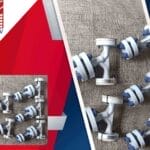The landscape of industrial processes across Indian industries is ever-evolving and so is the realm of strainer innovations. While many may not recognize it, industrial strainers play a crucial role in filtration systems. They are the unsung heroes that ensure operational efficiency. As industries continue to grapple with diverse challenges, from varying fluid viscosities to the need for enhanced environmental sustainability, the evolution of strainer technologies becomes a compelling narrative. This blog dives into the heart of “Strainer Innovations: Advancing Filtration Technologies for Pan-India Industries”. It explores the cutting-edge developments that are shaping the landscape of industrial filtration, safeguarding efficiency, and contributing to the seamless flow of operations nationwide. From materials engineering to smart monitoring solutions, the journey of strainers reflects a commitment to excellence and adaptability, essential elements for industries navigating the complexities of the modern era.
What are some of the general trends and innovations present in the field of industrial strainers?
Advanced Materials:
Manufacturers are exploring using advanced materials, such as corrosion-resistant alloys and high-performance plastics, to enhance the durability and performance of industrial strainers.
Innovative Filtration Technologies:
Continuous research is conducted to develop more efficient filtration technologies, including finer mesh sizes, self-cleaning mechanisms, and precision filtration systems to meet specific industry requirements.
Smart Monitoring and Automation:
Some industrial strainer systems are incorporating smart monitoring and automation features. This includes sensors for real-time monitoring of pressure differentials, flow rates, and other parameters, allowing for proactive maintenance and reducing downtime.
Customization and Modular Design:
Manufacturers are now focusing on providing more customizable solutions to meet the diverse needs of different industries. Modular designs allow for easy integration into existing systems and facilitate maintenance.
Environmental Considerations:
There has been a growing emphasis on environmentally friendly solutions. This includes the development of strainers with minimal environmental impact and those that can be easily recycled.
3D Printing Technology:
Some companies are exploring the use of 3D printing technology to create intricate and customized strainer designs. This could lead to more complex and efficient strainer geometries.
Improved Seal Designs:
Innovations in seal designs aim to prevent leaks and ensure a tighter seal, which is crucial in many industrial applications.
What is the importance of stainless-steel Y strainers in industrial filtration?
These specialized strainers, shaped like the letter ‘Y,’ are indispensable components in fluid handling systems across a myriad of industries. The importance of stainless-steel Y strainers lies not only in their robust construction but also in their ability to efficiently remove unwanted particles and debris from liquids, ensuring the integrity and longevity of downstream equipment.
One of the key virtues of stainless steel, the material of choice for these Y strainers, is its remarkable corrosion resistance. Industries, ranging from chemical processing to oil and gas, often deal with aggressive fluids that can wreak havoc on lesser materials. Stainless steel’s corrosion-resistant properties make Y strainers an ideal choice for applications where durability and longevity are non-negotiable. This resilience ensures that Y strainers maintain their structural integrity even in the face of harsh operating conditions, contributing to a more reliable and sustainable industrial filtration process.
The ‘Y’ configuration of these strainers is no mere aesthetic choice; it serves a crucial purpose in optimizing the filtration process. The Y-shaped chamber allows for a more efficient trapping of particulate matter. As fluid passes through the strainer, the debris is directed to the bottom of the Y, preventing clogs and minimizing pressure drops. This design not only enhances the overall efficiency of the filtration system but also reduces the frequency of maintenance, saving valuable time and resources for industrial operators.
Moreover, stainless steel Y strainers play a pivotal role in protecting downstream equipment, such as pumps, valves, and meters, from the detrimental effects of contaminants. By acting as the first line of defense, these strainers prevent abrasive particles from causing damage and disruptions in the industrial workflow. This proactive approach to filtration not only extends the lifespan of equipment but also contributes to enhanced operational reliability and reduced downtime.




